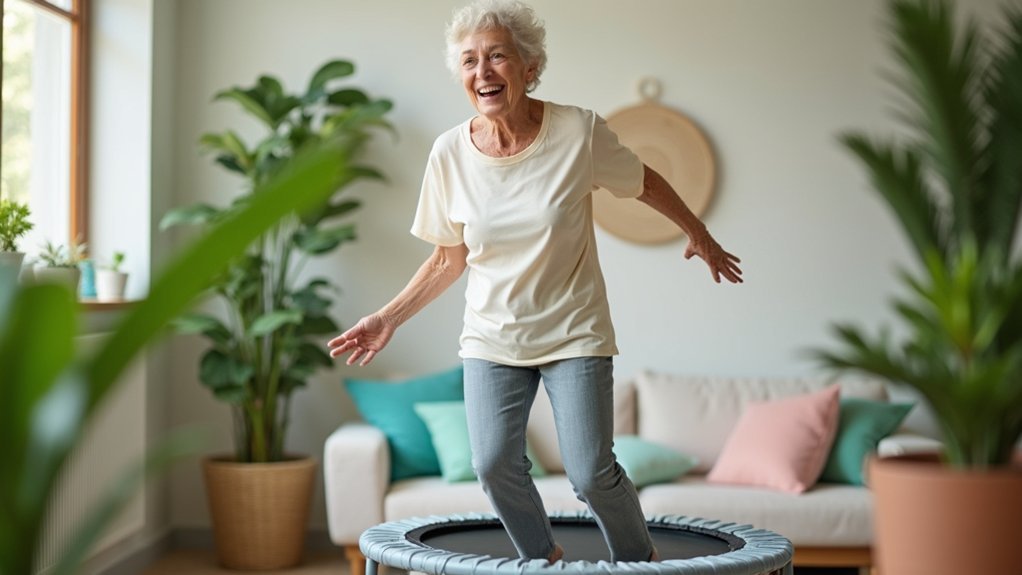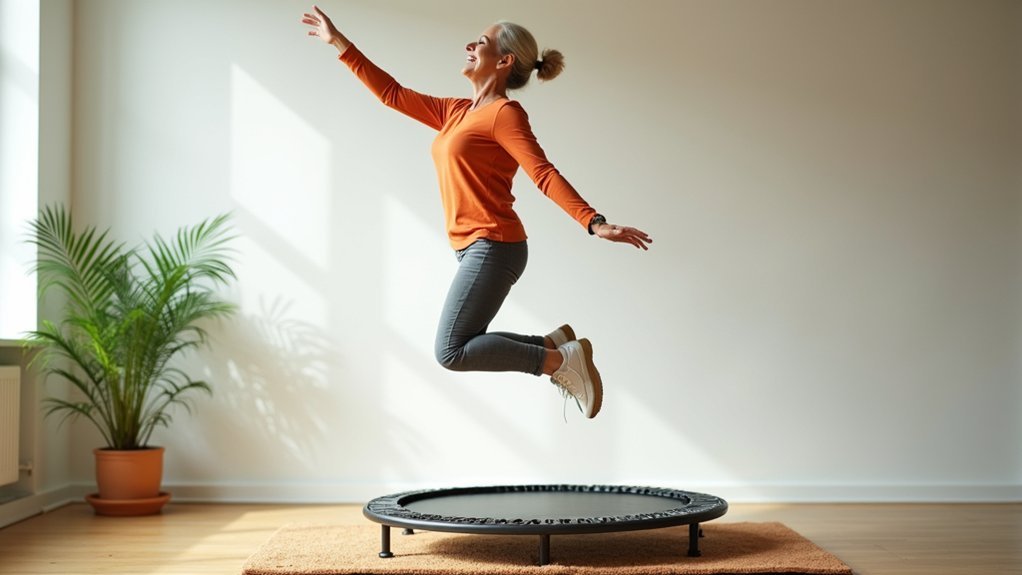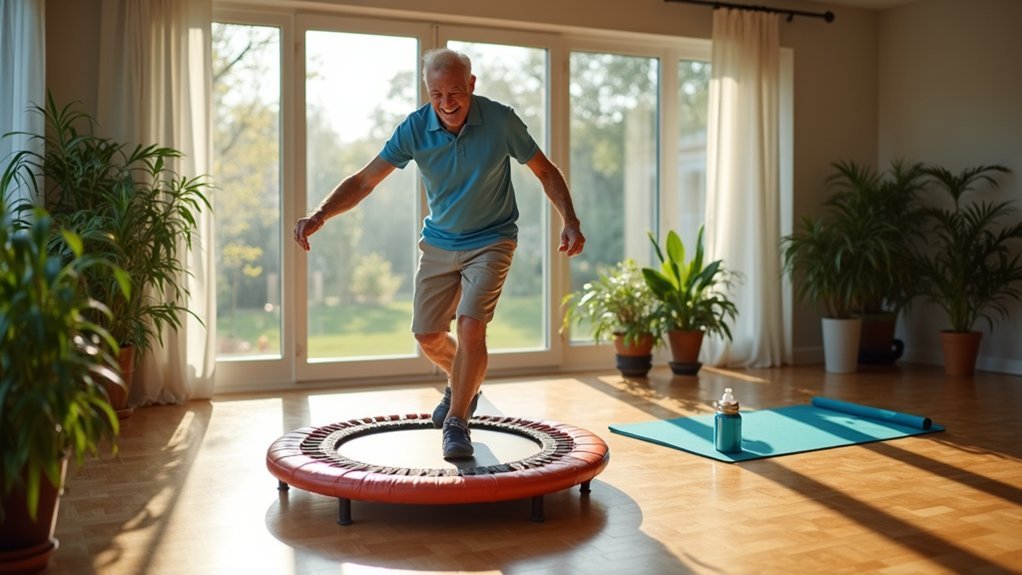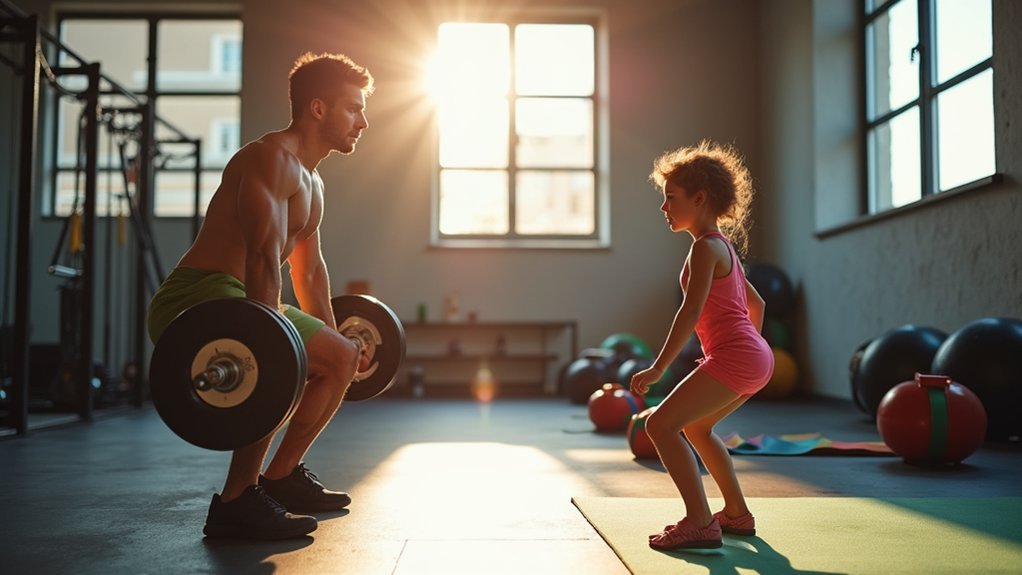Rebounding offers seniors a gentle yet effective way to strengthen joints without harmful impact. You’ll experience cardiovascular benefits while the mini-trampoline surface absorbs shock that would normally stress your knees and hips. The bouncing motion stimulates synovial fluid production, improves balance, and strengthens muscles supporting your joints. Start with basic health bounces using a stability bar for safety. Discover how this low-impact exercise can transform your mobility while protecting your aging joints.
What Makes Rebounding Ideal for Aging Joints

While many exercise options diminish with age due to joint concerns, rebounding stands out as a perfect solution for seniors. The elastic mini-trampoline absorbs shock, dramatically reducing impact on your knees, hips, and ankles compared to activities like running.
Age doesn’t have to limit movement—rebounding offers seniors a joint-friendly way to stay active without the punishing impact.
When you bounce, you’re strengthening periarticular muscles while encouraging synovial fluid production—a natural lubricant for stiff joints. The gentle, rhythmic motion stimulates circulation to flush inflammatory waste while preserving cartilage health.
You’ll experience improved balance and coordination through controlled landings that enhance proprioception and stability. This translates to better fall prevention and reduced fear of falling. Regular rebounding exercise helps seniors release endorphins that contribute significantly to mental well-being and mood elevation.
Best of all, rebounding creates mild osteogenic loading that supports bone density without fracture risk, making it ideal for osteoporosis management.
Essential Equipment: Choosing the Right Rebounder for Seniors
When selecting a rebounder, you’ll find stability features are non-negotiable for senior safety and confidence.
Look for models with sturdy frames, anti-slip mats, and reliable tension systems that provide consistent bounce without jarring impacts. Many quality rebounders include safety pads covering springs to protect feet from accidental slips, further enhancing workout safety for seniors.
Handlebar supports offer essential balance assistance during your rebounding sessions, with adjustable heights accommodating different user needs and exercise intensities.
Stability Features Matter
Because falls represent a serious concern for older adults, selecting a rebounder with proper stability features becomes paramount for safe exercise. You’ll want to prioritize models with stability bars featuring soft foam handles that provide reassurance while jumping. These bars don’t just prevent falls—they help you maintain proper form during workouts. Wearing no-slip grip socks provides additional safety when rebounding.
| Feature | Benefit | Why It Matters |
|---|---|---|
| Stability Bar | Balance support | Reduces fall risk |
| Non-slip Feet | Floor grip | Prevents rebounder movement |
| Low Profile | Easy access | Simplifies stepping on/off |
Look for rebounders with sturdy steel frames that won’t wobble during use. The best models combine visual contrast edges to prevent missteps with ASTM/EN safety certifications for peace of mind. Remember that proper stability features don’t just make rebounding safer—they’ll help you exercise with confidence.
Handlebar Support Options
Although many seniors initially focus on mat quality and bounce resistance, handlebar support options represent arguably the most essential safety feature for older adults using rebounders.
When selecting your rebounder, prioritize models with adjustable-height bars that accommodate your specific mobility needs and exercise intentions. Many beginners find handlebar rebounders especially helpful for maintaining proper posture and balance during their 15-minute routines.
Consider these key handlebar features:
- Detachable vs. fixed designs – choose detachable options if you’ll gradually build independence, or fixed bars for consistent support.
- Grip width and texture – wide-grip handlebars with non-slip rubber surfaces prevent hand fatigue and slippage during extended routines.
- Installation mechanism – look for tool-free setup with secure locking systems that prevent wobbling under pressure.
Getting Started: Safe Rebounding Techniques for Beginners

Since rebounding offers tremendous health benefits with minimal joint stress, it’s perfect for seniors looking to stay active.
Begin your rebounding journey with gentle exercises on a stable mini trampoline placed on a flat surface.
Start with a proper warm-up, like marching in place, before attempting basic health bounces. Stand with feet hip-width apart and bounce gently without lifting your feet off the mat.
For your health bounce, maintain a micro bend in knees and engage your abdominal muscles by drawing your navel back toward your spine.
As you gain confidence, incorporate side-to-side movements to improve balance.
Don’t rush into high-impact jumps—gradually increase intensity as your fitness improves. If you feel unsteady, choose a rebounder with a supportive handlebar.
Remember to cool down after each session to aid muscle recovery.
Always consult your healthcare provider before starting this or any new exercise routine.
5 Low-Impact Rebounding Exercises for Joint Protection
Low-impact rebounding offers seniors the perfect balance between effective exercise and joint protection. By focusing on gentler movements that maintain constant contact with the rebounder surface, you’ll reduce stress on vulnerable joints while still gaining cardiovascular benefits.
- Start with micro-bounces keeping a slight bend in your knees and ankles. This technique absorbs impact efficiently and prevents jarring movements that could stress your joints.
- Incorporate heel lifts and knee bends to activate lower body muscles without strain. These movements improve stability while maintaining the rebounding rhythm.
- Add gentle twists and side-to-side shifts to challenge your balance systems. These lateral movements strengthen stabilizing muscles and improve coordination without putting excessive pressure on your hips and knees. For additional support during these exercises, consider using a stability bar or chair to maintain proper balance and prevent falls.
The Science Behind Rebounding and Joint Health

The science behind rebounding offers compelling evidence for seniors seeking joint-friendly exercise options. NASA research has confirmed that rebounding provides cardiovascular benefits comparable to running but with considerably less joint strain. When you bounce, a unique gravitational stimulus occurs that strengthens bones and muscles without targeting specific joints. Rebounding is especially beneficial as it supports bone density and strength for individuals with osteoporosis.
| Joint Benefit | Scientific Explanation |
|---|---|
| Reduced Impact | Force distributed throughout body instead of concentrated on knees/ankles |
| Increased Circulation | Enhanced blood flow delivers nutrients to joint tissues |
| Muscle Protection | Strengthened muscles create natural joint support |
| Bone Density | Gentle impact stimulates bone growth without damaging joints |
Unlike high-impact exercises, rebounding creates a weightless moment at the top of each bounce, followed by a gravity-enhanced moment that benefits your musculoskeletal system without the harmful jarring effects.
Creating a 20-Minute Senior-Friendly Rebounding Routine
Your 20-minute rebounding routine should begin with gentle health bounces before progressing to low-impact cardio movements that strengthen without stressing your joints.
You’ll enhance stability through balance-focused exercises like single-leg holds and heel-toe rocks that challenge your coordination while protecting vulnerable areas.
Remember that 10 minutes of rebounding equals approximately 30 minutes of running, making it an efficient exercise option for seniors with limited energy or time.
Finish with a proper cool-down including static bouncing and deep breathing techniques to ease your body back to rest while maximizing the session’s joint benefits.
Start Slow, Progress Safely
When developing a rebounding routine for seniors, safety must take precedence over intensity, especially during the initial weeks.
Begin with the gentle bounce technique, keeping feet flat on the mat while maintaining low impact movements. This establishes proper form while gradually introducing your body to the rebounding motion.
Progress through these key phases:
- Foundation building – Start with 5-minute health bounces, incorporating rest intervals every 3-5 minutes while monitoring your comfort level.
- Stability development – Add heel-toe rock shifts and knee microbends to improve proprioception before attempting higher bounces. Focus on maintaining proper shoulder alignment to prevent upper body strain during these initial exercises.
- Gradual advancement – Slowly increase session duration before increasing intensity, maintaining bounces under 2 inches to protect joints.
Remember to use handrails when needed and verify surface tension before each session for best safety.
Balance-Building Bounce Sequence
Maintaining balance becomes increasingly essential for seniors as they explore the benefits of rebounding exercise. Start with a gentle 3-5 minute warm-up by marching in place, performing seated bounces, and alternating foot taps to gradually elevate your heart rate.
Progress to single-leg bounces for 30-second intervals, using a handle for support if needed. Incorporate side-to-side movements to build lateral stability, starting narrow before widening your stance as coordination improves.
Don’t neglect core engagement—try seated balance bounces with feet slightly raised, adding gentle torso twists. Improved posture and overall stability are additional benefits that come from consistent balance exercises.
Finally, integrate functional movements like high-knee marching while holding the handlebar.
Throughout your sequence, maintain soft knee bends, focus on proper posture, and track repetitions to measure progress over time.
Joint-Friendly Cool Down
Finishing a rebounding session properly is just as important as the workout itself for protecting senior joints and maximizing exercise benefits.
A proper cool-down helps your body shift safely from activity to rest while promoting flexibility and reducing potential stiffness.
- Gradually reduce your bouncing intensity over 2-3 minutes, moving from higher bounces to gentle toe taps, allowing your heart rate to decrease naturally.
- Perform gentle stretches while standing on your mat or seated if needed—focus on your calves, hamstrings, and shoulders for 30 seconds each without bouncing.
- Practice deep breathing with 5-6 slow breaths, inhaling for four counts and exhaling for six, which helps relax your muscles and reduces joint tension.
- Side stretches can be particularly effective for relieving back tension that may have accumulated during your workout, as recommended by fitness coach Marc Montemerlo.
Remember to hydrate immediately after your cool-down to support joint health.
Measuring Progress: Physical Benefits Beyond Joint Health
While joint protection remains a primary goal, rebounding exercises offer seniors a wealth of measurable benefits extending far beyond arthritis management.
You’ll notice improvements in bone density, especially in the hip and spine regions, with 12-week programs showing significant markers of enhanced bone health.
Track your balance improvements—studies show a 35% better recovery after just 14 weeks of mini-trampoline work.
After just 14 weeks of mini-trampoline exercise, seniors can expect 35% improved balance recovery—a measurable gain worth tracking regularly.
Your cardiovascular system benefits too, with improved circulation and oxygen delivery during sessions. Regular rebounding exercise can effectively reduce fall risk by enhancing stability and coordination in daily movements.
Monitor your strength gains in lower limbs and core muscles, which directly translate to better gait performance and daily mobility.
Many seniors also report reduced chronic pain and improved stress levels thanks to the rhythmic, endorphin-releasing nature of rebounding exercises.
Combining Rebounding With Other Senior Fitness Activities
Rebounding exercises gain even more power when strategically paired with other senior-friendly activities.
You’ll maximize your fitness journey by creating a well-rounded routine that addresses multiple aspects of health while protecting your joints.
- Balance enhancers – Complement your rebounding with tai chi or yoga poses to improve stability, strengthen your core, and further reduce fall risk—something particularly valuable as you age.
- Strength builders – Add resistance bands or light weights to your rebounding routine to increase muscle engagement without stressing joints, helping maintain independence in daily activities.
- Cardiovascular boosters – Alternate between rebounding sessions and activities like brisk walking, swimming, or modified dance workouts to strengthen your heart while enjoying variety in your fitness regimen. Incorporating deep breathing techniques during your rebounding warm-up enhances oxygen flow and promotes relaxation while preparing your body for exercise.
Real Stories: How Seniors Transformed Their Joint Health
Beyond the science and statistics, the most compelling evidence for rebounding comes from seniors who’ve experienced remarkable transformations firsthand.
Consider the homebound individual who rediscovered mobility after four years of limitations, finding exhilaration through gentle rebounding. Others have rebuilt ankle strength through careful protocols, starting with sit bouncing before progressing to vertical rebounds as confidence returned.
One success story documents a 50-pound weight loss through joint-friendly rebounding, while maintaining muscle mass that traditional cardio couldn’t provide.
In another case, a twelve-week program helped seniors with osteopenia improve both limb strength and bone stability.
Many participants report unexpected benefits: reduced stress incontinence, decreased fear of falling, and renewed independence. The low impact nature of rebounding makes it particularly suitable for seniors with existing hip problems or injuries who still want to maintain an active lifestyle.
These real-life transformations highlight rebounding’s unique capacity to deliver cardiovascular benefits without sacrificing joint health.
Precautions and Modifications for Specific Joint Conditions
For seniors experiencing joint concerns, rebounding offers tremendous benefits when approached thoughtfully with proper modifications.
You’ll need to adapt your routine based on your specific joint conditions to guarantee safety while maximizing health benefits.
1. Knee protection requires reducing jump height, wearing supportive bands, and strengthening surrounding muscles. Trampoline socks provide essential traction and prevent dangerous slips during your rebounding workout.
Stop immediately if you experience pain and focus on gentle landings.
2. Hip joint care means avoiding deep twists, incorporating stability exercises, and guaranteeing soft landings.
Consider consulting a physical therapist for personalized modifications.
3. General safety should include proper warm-up routines, appropriate equipment selection, and gradual intensity progression.
If you have arthritis or previous injuries, consult your healthcare provider before starting.
Frequently Asked Questions
Can Rebounding Help With Osteoporosis in Seniors?
Yes, rebounding can help with osteoporosis by stimulating bone growth through increased gravitational load. It’s a low-impact exercise that improves your bone density, balance, and strength while reducing your fall risk.
How Long Before Seniors Notice Improved Balance From Rebounding?
You’ll typically notice improved balance after 3 weeks of consistent rebounding (3 sessions weekly). Initial proprioceptive benefits start immediately, while significant improvements appear around 6-8 weeks with continued practice.
Is Rebounding Safe for Seniors With Pacemakers?
You can rebound with a pacemaker, but you’ll need your doctor’s clearance first. Use low bounces, maintain proper posture, and start with brief supervised sessions. Listen to your body and stop if symptoms occur.
Should Seniors Wear Special Shoes When Rebounding?
Yes, you should wear shoes with non-slip soles and ankle support when rebounding. They’ll provide stability, protect your joints, and help prevent falls. Choose lightweight options with adjustable fits for comfort and safety.
Can Rebounding Help Reduce Arthritis Pain?
Yes, rebounding can help reduce your arthritis pain through its low-impact nature that absorbs shock, while stimulating circulation and lymphatic drainage. You’ll experience less joint strain than walking with similar benefits.
In Summary
You’re now equipped to bounce your way to better joint health. By incorporating rebounding into your fitness routine, you’ll strengthen your joints without the harsh impact of traditional exercises. Start slowly, listen to your body, and enjoy the gradual improvements in mobility and strength. Whether you’re managing arthritis or simply maintaining health, rebounding offers an accessible path to active senior living.





Leave a Reply